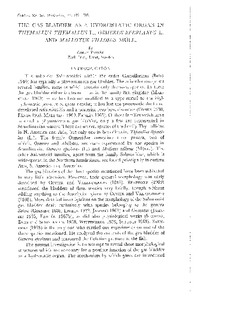| dc.description.abstract | 1. The gas bladder of Thymallus thymallus is investigated concerning
the topography, vascularization, histology and histochemistry. Simple
micro-retia mirabilia are found, forming a counter-current vascular system
of probably very low exchange capacity. The epithelium, lining the lumen,
is probably one of very low activity. If a secretion of gases into the bladder
occurs, it is probably very slow.
2. The gas bladder of Osmerus eperlanus is investigated as described
above. The blood vessels are not arranged as a counter-current system,
though capillaries reach the base of the epithelium. The epithelium,
which is also EM investigated, contains apically considerable amounts
of mucopolysaccharides and glycogen. A secretion, directly to the lumen,
of gases or of a matter which can be transformed into gases, is proposed.
3. The gas bladder of Mallotus villosus is investigated as described
under point 1. Besides, low power electron micrographs has been studied,
and analyses of the gaseous content of the bladder were made after
administration of pilocarpine, dibenzyline and yohimbine. No counter
current vascular system is present but capillaries reach the base of the
epithelium. The epithelial cells contain and probably secrete polysaccharides
(though not glycogen) directly to the lumen. The gas is composed
of 0-2% carbon dioxide, 0-18% oxygen and 80-100% inert gases.
The administration of drugs did not in any case increase the percentage
of oxygen or carbon dioxide, compared with the control animals. It
is proposed that no gas secretion occurs.
4. The muscle layer of the gas bladder is in all the three species
continuous with the muscularis externa of the oesophagus. This argues
for a neutral terminology concerning the layers of the gas bladder wall.
5. A muscular sphincter is morphologically documented at the debouch
of the pneumatic duct into the oesophagus.
Supported by grants from the Faculty of Mathematics and Science
of the University of Lund. Photos by B. Henriksson. | |
